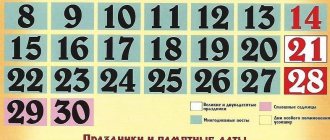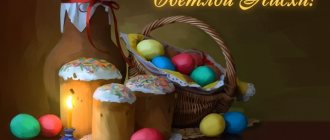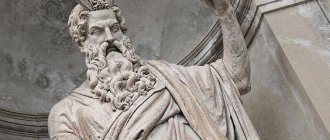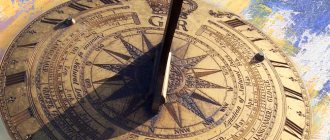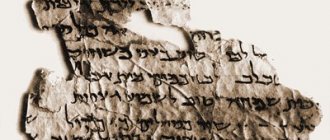The question “why is Easter at a different time every year?” sooner or later every Christian asks himself. Some people attribute this to established church traditions and stop racking their brains in vain, while for others their natural curiosity gives them no rest. What's the matter? Why did Easter fall into the category of moving holidays, since Christ was resurrected on a specific day? Let's try to figure it out.
What date is Easter celebrated in 2021?
Easter marks the end of the 40-day period of Lent. The week leading up to Easter is called Holy Week by Christians because it commemorates the events surrounding the crucifixion, burial and resurrection of Jesus Christ.
Easter does not have a fixed date, but Orthodox Christians always celebrate it on the Sunday between April 4 and May 8
. Orthodox churches celebrate moving dates according to the Julian calendar, the Roman calendar first proposed by Julius Caesar in 46 BC. e.
In 2021, Orthodox Christians celebrate Easter on May 2 .
Why Easter is celebrated on different days: commentary from a priest
In Orthodoxy, Easter is called a moving holiday. This means that its date changes every year, because the first full moon falls at one time or another. By the way, moving (or sliding, movable) holidays also include such Orthodox dates as the Days of Remembrance of Saints, Councils of Saints and some others.
It’s interesting that people also have their own moving holidays - for example, try to name the exact date of Easter. And many professional days (architect, miner, veterinarian, etc.) are celebrated on the first/second, etc. Sunday of the month. So there are more than enough analogies from ordinary life.
Priests repeatedly point out that there is no confusion in this phenomenon. Yes, it’s clear why Easter is a moving holiday - it’s just always celebrated at different times.
And of course, it is better to see once than to hear a hundred times. The answer to the question discussed can be seen here.
Why is Easter celebrated in the spring?
According to the Bible, the death and resurrection of Jesus Christ occurred during the Jewish Passover (Passover).
In 325, the church held the First Ecumenical Council, known as the Council of Nicaea. Until this time, churches around the world celebrated Easter at different times.
To achieve unity between the churches, the members of the cathedral created a formula for a single day of celebration of Easter.
It was decided to celebrate Easter on the first Sunday that falls after the first full moon after the vernal equinox, but always after the Jewish holiday of Passover.
To avoid further confusion, the date of the vernal equinox was determined to be March 21st. This system ensured that all churches would celebrate Easter together on the same day.
Although the Council of Nicaea established the date of Easter for churches around the world, not all Christian churches observe Easter according to the Gregorian calendar. Orthodox churches celebrate Easter according to the Julian calendar.
Why Easter is at different times every year: what does the first full moon have to do with it?
Indeed, the fact that the holiday is constantly celebrated at different times does not at all explain the connection with the first spring full moon. To do this, we can turn to modern sources (for example, look at Wikipedia).
And you also need to rewind time almost 2000 years ago - to find yourself in the era of the life of Christ, or rather, his heroic death. The fact is that the Savior died on Friday, and when he was resurrected, the main holiday of the Jewish people, Passover, took place in Israel.
The consonance of this word with Easter is by no means accidental: in fact, this is where the name of the favorite Christian celebration comes from. This date has sacred significance for the Jews, because it was on this day that Moses began to lead the people out of Egyptian slavery.
The outcome turned out to be successful - as a result of long trials, the Jews finally found their promised land. Today we call it Israel. However, not only today - the name of the state has not changed for several millennia.
The Passover holiday itself is celebrated on the 14th day of Nisan - this month of the Jewish calendar exactly corresponds to our March and April. It is celebrated on the first full moon of spring.
This is believed to be an incredibly ancient tradition, possibly going back even further than the age of Moses. The first full moon is a kind of starting point that finally marks the arrival of spring.
What is spring for ancient people? This, without exaggeration, is life itself. Sowing time begins, the length of the day increases, it becomes warmer and warmer, and the first berries and other fruits finally ripen in the forests. Perhaps this is why Easter leaves few people indifferent - even people far from the Christian religion.
Orthodox and Catholic Easter
The date on which Christians celebrate Easter not only differs every year, but also between the Orthodox and Catholic churches. This is due to the fact that they use different calendars to calculate the date of Easter: the Catholic one uses the Gregorian calendar, and the Orthodox calendar uses the older Julian calendar.
Currently, the old Julian solar calendar is 13 days behind the Gregorian calendar, and its lunar calendar is 4-5 days behind, which is why the date of Orthodox Easter often does not coincide with the date of Catholic Easter. Therefore, Easter for Catholics most often occurs in the period from March 22 to April 25
according to the Gregorian calendar.
Orthodox Easter is usually celebrated 1-5 weeks later than Catholic Easter, but sometimes their dates coincide, as in 2017. The next coincidence will occur in 2025.
PORTAL CONTACTS
Why is Easter celebrated at different times every year?
Answered by priest Mikhail Vorobyov, rector of the temple in honor of the Exaltation of the Honest Life-Giving Cross of the Lord in the city of Volsk
The holiday of Easter, or the Holy Resurrection of Christ, is the main moving holiday of the church calendar. This feature of the holiday is determined by the fact that it is tied to the extremely complex solar-lunar calendar adopted by the Jews. The Resurrection of Christ occurred on the days when the Jews celebrated their Passover, which for them was a memory of the exodus from Egypt. The Jewish holiday of Passover is not a moving holiday in the Jewish calendar: it was always celebrated from the 14th to the 21st day of the month of Abib (Nisan). The 14th of Nisan in the Jewish solar-lunar calendar, by the very meaning of this calendar, was the first full moon after the vernal equinox. During the era of the earthly life of Jesus Christ, the vernal equinox fell on March 21 according to the Julian calendar (named after Julius Caesar). Therefore, the Jewish holiday of Easter, already in the Julian calendar system, became moveable: it fell on the first full moon after March 21, and Christian Easter was celebrated on the first Sunday after this day. (If March 21 coincided with the full moon and Sunday, then Christian Easter was celebrated a week later, on March 28.)
The first full moon after the spring equinox may occur between March 21 and April 18. If the full moon on April 18 falls on a Sunday, then Christian Easter is celebrated a week later on Sunday April 25, since the sequence of events in biblical history requires that the Resurrection of Christ be celebrated later than the first day of the Jewish Passover.
Thus, the Orthodox holiday of Easter can be celebrated on any day from March 22 to April 25 according to the Julian calendar (old style), or (in the 20th and 21st centuries, when the difference between the Julian and Gregorian calendars is 13 days) from April 4 to May 8 inclusive according to the new style.
However, the alternation of dates on which Orthodox Easter is celebrated, within the interval from April 4 to May 8, is subject to complex rules related to the difficulty of coordinating the solar and lunar years. The minimum period of time in which the dates of the Easter holiday occupy all possible positions is 532 years. This huge period of time is called the Great Indiction. After the Great Indiction, the dates of Easter begin to alternate in the same order. Therefore, it is enough to have one calculated Easter for a period of 532 years, after which everything will be repeated.
The period of time from April 4 to May 8 defines the holiday of Easter in the Orthodox Church. The Roman Catholic Church and most Protestant denominations calculate Easter based on the date of the vernal equinox on March 21 according to the Gregorian calendar (new style). This starting point in the Easter calculations gives completely different dates for the Easter holiday. Therefore, Easter for Roman Catholics and Western Protestants occurs between March 22 and April 25 according to the Gregorian calendar. In rare cases, it coincides with Orthodox Easter. Since the Jews, unlike Western Christians, did not change their historical calendar, their 14th Nisan is still counted from the vernal equinox on March 21 in the Julian (April 3 in the Gregorian) calendar. Thus, Catholic Easter in some years may coincide with Jewish Easter and even precede it, which contradicts the sequence of events in the earthly life of Jesus Christ.
Easter: Date Conversion Through the Centuries
Many years ago, Jesus Christ accepted crucifixion for the sins of the world's population and was resurrected on the 3rd day. The lunar calendar, used in ancient times, foresaw the celebration of Christ's Day on Sunday, which was considered the first day of the week, and was celebrated on the 14th day of the original month of spring. Before the Babylonian captivity, the Jews called this month Aviv, after which it was called Nissan. There was no general calendar, so the Israelis used the lunar calendar, the Egyptians and Romans determined time according to the solar one.
The main properties of the lunar and solar calendars
What is the lunar calendar:
- Includes 12 months;
- A month consists of 29 or 30 days;
- The calendar year lasts 354 days.
Personalities of the solar calendar:
- Divides the year into 12 months;
- Any month has 30 days;
- The total number of days in a calendar year is 365.
You see, the difference in the length of the calendar year is 11 days, because in order to balance the total number of days, the Jewish people decided to add Ve-Adar to the “accumulated” month once every couple of years. In our normal world of awareness, this year would fall on what we call a “leap year.”
Even at this moment, the Jews have not changed the traditions that have developed over the centuries: the 14th of Nisan is calculated from the day of the equinox, which takes place in the spring, according to the Julian, and not the Gregorian calendar, accepted in the world. Thanks to this circumstance, the Easter of Catholics and Jews can coincide, and the first can even precede the second, disrupting the natural course of biblical history.
Representatives of some other nations perceived it as true that the calendar year contains only 10 months, only 304 days. March was considered the beginning of the year (January and February were considered the last of the year).
Jewish Passover
In ancient times, Christian Holy Sunday was directly related to the celebration of Jewish Passover.
The meaning of Jewish Passover differs from Christian Passover and is to celebrate the freedom of the Jews. The events took place in the 13th century BC. You can read about this in the Old Testament, Book of Exodus. It tells in detail about the time when the Egyptians oppressed the Jewish people, mocking them in every possible way. The Lord heard the fervent prayers of the Jews and sent Moses to help them, who was supposed to persuade the Egyptian pharaoh to free the Jewish people. But Pharaoh refused, after which the Lord brought down heavenly punishment on the Egyptians. The Lord said that all firstborn boys must die. But the Jews were commanded to paint marks on their houses with the blood of lambs. All the Egyptian children were dead, but the Jewish boys remained alive. After this execution, Pharaoh freed the Jewish people from slavery, and the Jews followed Moses to the Holy Land. Since then, every year Jews celebrate liberation from Egypt on this day. In memory of those events, a lamb is slaughtered and national dishes are prepared. The lamb (lamb) symbolizes Jesus Christ, who became the savior of people, having been crucified for the sins of everyone living on earth.
For the first hundred years of Christianity, believers celebrated Holy Sunday twice:
- The first half celebrated the 14th of Nisan according to the Jewish calendar, together with the Jews. This day was a symbol of the crucifixion of Jesus Christ and his death.
- The second half, which turned out to be the majority, celebrated after the 14th of Nisan on the first Sunday, and this day symbolized the joy that Jesus Christ was resurrected.
In 325, the first Ecumenical Council decided on a unified calculation of Easter and announced how the date of Great Easter was determined. It must be celebrated after the date of the Jewish Passover, on the Sunday first after the first full moon of spring. The full moon should be either on the date of the spring equinox or immediately after it, but not earlier.
When is Easter celebrated?
Find out what awaits you today - Horoscope for today for all zodiac signs
Due to numerous requests from subscribers, we have prepared an accurate horoscope application for mobile phones. Forecasts will arrive for your zodiac sign every morning - it's impossible to miss! Download for free: Daily Horoscope 2020 (available on Android)
Christian Easter is celebrated on the first Sunday following the first full moon following the vernal equinox (that is, the date when the length of night and day are the same). If the first full moon coincides with the seventh day of the week, then the celebration is moved forward a week.
How to determine the date of Easter
In addition to the above method, there is also an arithmetic one. It consists of simple operations and numbers and was invented by Gauss, a German mathematician and scientist in the 19th century.
Easter is celebrated on the first Sunday after the spring full moon
First you need to divide the number of the desired year by 19 and select the remainder. The same thing needs to be done two more times, but with the numbers 4 and seven. We have 3 remainders after each action. Now we multiply the first remainder by 19 and divide by 30, find the remainder. We multiply the second remainder by 2, the third by 4, the fourth by 6. We add the resulting data and add 6, divide by 7. We find the remainder again.
If the sum of the fourth and fifth balances is less than 9, then the month of celebration is March. Now all that remains is to determine the date. Let's add the fourth and fifth remainders and add 22. The resulting number is the date of the celebration.
If the sum of the fourth and fifth remainders is greater than 9, then the month of celebration is April. To determine the date, add the fourth and fifth remainders and subtract 9. The resulting number is the date of the celebration. This method will be relevant until 2101. Later, due to a break in calendars, it will be slightly changed.
Traditions of celebrating Christ's Resurrection
Christians congratulate each other on Easter with a joyful cry of “Christ is Risen!” - “Truly He is Risen!” These are not just words, but a confirmation of our faith and devotion to Christ. We believe that Christ threw off the shackles of death and was God, and not just a man who fell into a lethargic sleep or fell into a coma. The resurrection of Christ was a true miracle. On the eve of this bright day, believers consecrate the Easter meal, the symbols of Easter - Easter cakes, Easter cottage cheese, colored eggs.
Easter cakes are baked from kvass dough. Even this preparation is a symbol of the Resurrection of Christ. The dough sours and then comes to life in the hands of the cook, just as Christ came to life.
Eggs are painted for Easter because it is believed that Mary Magdalene once gave the first Easter egg to Emperor Tiberius. She brought it as a gift to announce the Resurrection of Christ and brought the egg, because in those days it was not customary to come empty-handed. Emperor Tiberius replied that no one can be resurrected, just as a white egg cannot suddenly turn red. At that same second the egg turned red. It may be nothing more than a legend, but Christians paint eggs red. Although other colors and decorations in honor of the holiday are acceptable. Red is also the color of Royal glory. Symbol of the Heavenly Kingdom.
But the main tradition for Christians was and remains the Easter service. Easter in 2021 will take place on April 28 and the Easter service will begin according to tradition at 12 am.
Easter traditions observed by believers
Before celebrating Easter, believers observe Lent for more than 40 days. It includes very strict dietary restrictions. Thus, food of animal origin is completely prohibited. In other words, you cannot eat meat, milk, eggs, dairy and fermented milk products, etc. Believers cannot even eat fish except for two days.
However, the diet may well be varied. After all, fruits and vegetables, berries, nuts, seeds, baked goods, baked goods that were prepared without animal products, as well as legumes, whole grains, cereals, etc. are allowed. On the day of the holiday, believers rejoice that Jesus Christ defeated death and evil and rose again. The Son of God made a sacrifice for the sins that people had committed. They begin to celebrate Easter on Saturday evening. So, in churches there is a procession of the cross. And the table is covered with all sorts of goodies. The main dishes are Easter cakes and colored eggs.
There are some prohibitions that should be observed on the day of the holiday. So, you cannot clean the house, do laundry, ironing, sewing, embroidery, knitting, do hard work and work in the garden, get married, baptize children, take out trash from your house, cheat, quarrel with people. A big holiday should be celebrated with family around one big table.
Easter traditions and customs
Over its centuries-old history, the holiday has acquired folk traditions. The younger generation absorbs them with mother's milk. The celebration unites people all over the world, and although there are slight differences in the celebration, there are unchanging traditions that believers follow from year to year. The most important customs and traditions:
- Bake Easter cakes, each housewife has her own recipe. Putting their whole soul into preparing Easter cakes, the craftswomen bake real works of art;
- Paint eggs, because the shell is a symbol of new emerging life. A large stone covered the entrance to the tombs where the Savior was buried; it was shaped like an egg. Previously, eggs were painted only red, as a symbol of the blood of the Son of God. Much later it became a tradition to paint them in different colors;
- Gathering together as one friendly family around a large table;
- On a bright holiday, according to tradition, it is customary to greet with the words: “Christ is Risen!”, and to answer: “In truth He is Risen!”. People also hug each other and kiss each other three times on both cheeks. This form of greeting lasts 40 days;
- After a home feast, you must definitely go to visit your neighbors and bring them your treats;
- Children's games with colored eggs are also obligatory; they are not only not forbidden, but are encouraged in every possible way;
- They decorate the house with fresh flowers, eat only from festive dishes, and there should be a snow-white starched tablecloth on the table;
- The bright celebration lasts 40 days. After all, that’s how long Jesus was on earth after his miraculous Resurrection.
